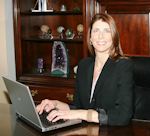Laser conference opens a window to medicine
FLORENCE, ITALY—In October, attendees from around the world gathered for Laser Florence 2000, "A Window on the Laser Medicine World." The conference included the Third International Meeting in the field of laser applications in medicine and biology, with hands-on courses in laser medical applications. The 15th International Congress on Laser Medicine (ICLM) 2000 also convened with the conference.
The event was an international effort, organized by the Laser Florence Scientific Board, which includes specialists from the following countries: Argentina, Austria, Germany, Great Britain, Hungary, India, Italy, Romania, Russia, Spain, and the United States. Laser societies and organizations from each country co-sponsored the conference.
The Third International Meeting included educational courses by medical specialists in fields as diverse as laser phlebology, laser dentistry, and laser urology. The 15th ICLM 2000, which was moved in 1999 from Munich, Germany to Florence, included multiple sessions on laser topics from biomodulation to wound healing. Other categories included ear, nose, and throat (ENT), laser resurfacing, laser ophthalmology, and laser pain treatment. Congress participants included 150 scientists selected by the International Scientific Board of the conference.
Highlighting ICLM was a retrospective on the first 40 years of laser medicine. From the first medical laser report, to laser tissue welding as a biotechnological advance for the future, the history of medical lasers was reviewed, along with the relations between laser medical use and the laws guiding the medical practices.
The presentations in the ENT session dealt primarily with laser otolaryngology and laser myography for noninvasive treatment of facial musculature problems. In the laser surgery category, scientists from Munich University (Germany) and Ancona University (Ancona, Italy) reported a new procedure for the treatment of prostatic hyperplasia, using the combination of interstitial laser coagulation and high-frequency-current transurethral resection of the prostate.
The power to heal
One of the most promising results of the research presented was the molecular modification of cytostatic drugs by ultraviolet/visible irradiation, increasing their efficiency in cancer treatment, as reported by Romanian physicists. In laser tissue-welding, pediatric urologists from Weill Cornell Medical Center of New York-Presbyterian Hospital (New York, NY) reported a new clinical application on vascular tissue, mucous tissue, and skin that is being implemented in the United States and Europe.
The wound-healing session included an update on diabetic-wound-healing research on rats using low-power laser irradiation. New data on cellular mechanisms using low-power laser modulation was presented, along with the latest techniques using lasers and fibroblasts in cosmetic and aesthetic medicine.
The resurfacing and plastic-surgery chapter was devoted to ablative and nonablative resurfacing, including ultrapulse-laser facial resurfacing in closed skin, the treatment of stretch marks and hypertrophic scars, and facial regeneration with a superficial erbium:YAG laser.
In the sports-injuries field, laser acupuncture for pain treatment was first reported. Doctors from Siena University (Siena, Italy) presented statistical results showing that patients treated for fibromyositis had better results with a higher-energy 810-nm diode laser with less exposure time than patients treated with a 904-nm diode laser.
The gynecology and urology session covered the use of lasers in gynecological endoscopy and the effect of laser therapy on human papilloma virus. The ophthalmology session reported on the use of photodynamic therapy for the treatment of age-related macular degeneration.
Dentistry results were presented on the bactericidal effects of lasers on root canals, laser techniques in teeth treatment without anesthesia, and the clinical use of lasers in children's oral diseases.
The light biomodulation session included reports on the role of blood photomodification in therapeutic effects of the visible light, the effects of the visible polarized light at therapeutic doses on some parameters of humoral immunity, and the use of visible incoherent polarized light in the treatment of second-degree burns. Russian specialists reported on the nonsurgical use of lasers in the treatment of various infections, including those caused by acquired immune deficiency syndrome.
Laser Florence 2001 will be held Nov. 7-11 next year.
Mihail-Lucian Pascu and Valerie C. Coffey
Mihail-Lucian Pascu is a professor of physics with the National Institute for Laser, Plasma and Radiation Physics in Bucharest, Romania.

Valerie Coffey-Rosich | Contributing Editor
Valerie Coffey-Rosich is a freelance science and technology writer and editor and a contributing editor for Laser Focus World; she previously served as an Associate Technical Editor (2000-2003) and a Senior Technical Editor (2007-2008) for Laser Focus World.
Valerie holds a BS in physics from the University of Nevada, Reno, and an MA in astronomy from Boston University. She specializes in editing and writing about optics, photonics, astronomy, and physics in academic, reference, and business-to-business publications. In addition to Laser Focus World, her work has appeared online and in print for clients such as the American Institute of Physics, American Heritage Dictionary, BioPhotonics, Encyclopedia Britannica, EuroPhotonics, the Optical Society of America, Photonics Focus, Photonics Spectra, Sky & Telescope, and many others. She is based in Palm Springs, California.